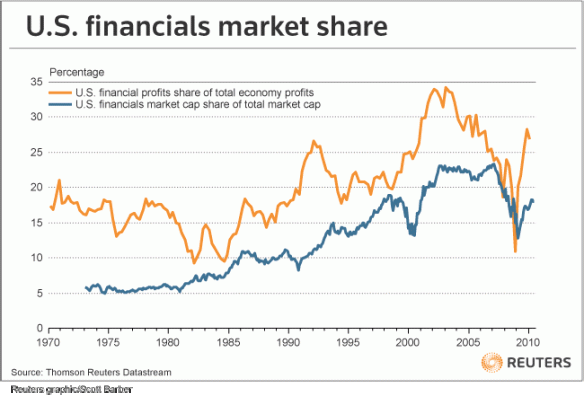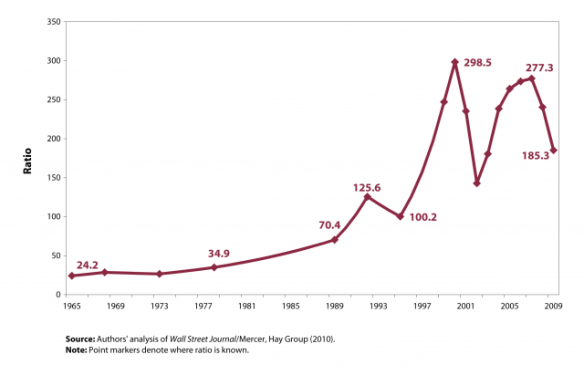The other side of Acts 1 through 3, where the average American citizen began to load up on debt and credit to be able to live the middle class American Dream, is the rise of the financial industry. An excellent movie to watch that does “Act 4” much more justice is Inside Job (Movie). If you have cable and Encore, it is available now. When Ronald Reagan deregulated the financial sector and the following presidents continued to open the gates, the financial sector growth exploded. Banks were allowed to merge and become large. Investment banks went public such that the money in their coffers was no longer limited to partners money and freed them of risk (now they have other people’s money to play with). Big funds went towards lobbying for further deregulation. Ex-bankers and investment bankers took key positions in the Federal Reserve and within presidential administrations. Credit cards, home equity lines, car loans, banking fees, home loans, 401k’s, IRA’s, securities purchases, stock options — the flood gates were opened wide.

The sector as a percent of GDP tripled and profits began to represent one-third of the total profits generated by the american economy. The financial sector was generally making money off money which most would classify as a Ponzi-scheme. The fallout was clear, from the Savings and Loan crisis when tax payers lost $124 billion, to the DOT COM internet bubble, to Enron and other corporate frauds aided by the investment community, to the housing scam. These scams sucked immense wealth away from the average american citizen and gutted many industries.

But the money created on money didn’t just disappear. The money gains on money went to those on top in the financial industry. Bonuses on annual results sky-rocketed on Wall Street and within banks. Those in the financial sector began to become extraordinarily wealthy while the average american citizen loaded up on debt and experienced stagnant wages. This same trend continues today unabated despite the debacles which have occurred since financial deregulation. And one cannot just look at the financial sector for an explanation of the reprocessing of the middle class. One also must take a look at what is going on with corporate america. Wall Street and the executives of larger U.S. corporations have the same agenda.
 Corporate profits in american companies have grown consistently over the decades to reach record levels, yet the average american worker isn’t participating in those profit gains. The goal of large corporations is to maximize profits and returns for Wall Street investors. As such, the average american worker is viewed as an expense and is therefore expendable relative to the goal of the firm. Those executives that either squeeze the most out of remaining american employees (for productivity) or source cheaper labor abroad, are rewarded handsomely via stock options and bonuses. Wall Street and executive leaders of big U.S. corporations are on the same page and both participate in the immense personal gains in wealth.
Corporate profits in american companies have grown consistently over the decades to reach record levels, yet the average american worker isn’t participating in those profit gains. The goal of large corporations is to maximize profits and returns for Wall Street investors. As such, the average american worker is viewed as an expense and is therefore expendable relative to the goal of the firm. Those executives that either squeeze the most out of remaining american employees (for productivity) or source cheaper labor abroad, are rewarded handsomely via stock options and bonuses. Wall Street and executive leaders of big U.S. corporations are on the same page and both participate in the immense personal gains in wealth.
 The largest increases in compensation for corporate executives has come in the form of stock options. Once stock options became a key means to pay corporate executives, the goals of Wall Street and big business became aligned. Long-term strategic growth became less important than meeting the short-term expectations of Wall Street analysts. The executive that could beat Wall Street expectations in the short-term made him or herself very wealthy in addition to Wall Street bankers and big hedge funds.
The largest increases in compensation for corporate executives has come in the form of stock options. Once stock options became a key means to pay corporate executives, the goals of Wall Street and big business became aligned. Long-term strategic growth became less important than meeting the short-term expectations of Wall Street analysts. The executive that could beat Wall Street expectations in the short-term made him or herself very wealthy in addition to Wall Street bankers and big hedge funds.
This link between executives and Wall Street (stock option compensation) led to debacles like Enron and it continues today via the legalized fraudulent Initial Public Offering (IPO) process. Billionaires are minted in a matter of years simply because they are loaded up with a huge number of private shares that they can dump after a short lock-up period post public offering. And Wall Street gets rich on public offerings, both through underwriting and the creation of bubbles like the DOT COM debacle, the housing scam and related fancy investment instruments, and now the social networking bubble with Facebook and Twitter as the show pieces. Recent cases in point include Google and Facebook. The amount of money concentrated between five people who founded these companies equates to approximately $80 billion dollars based on their private shares received prior to going public. Are five men really worth that much money? I don’t think so. Remember, money does not grow, it is simply accumulated by those that can siphon huge amounts away from the average person. There is no win-win situation at this point, there is only win or lose.


